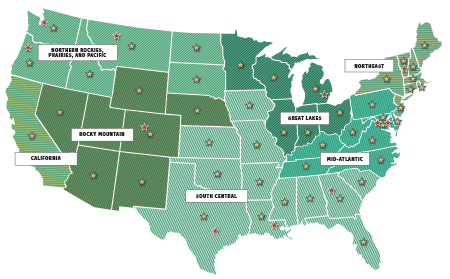Maintaining healthy wildlife populations, recovering endangered species, and restoring impaired ecosystems all require significant funding.
Unfortunately the needs of wildlife conservation efforts far outstrip the financial resources currently available to federal, state, and tribal agencies.
Indeed, in the face of climate change, these needs and associated costs are expected to grow sharply.
This plight of wildlife has become even more acute in light of the current economic downturn, as many natural resource agencies suffer budget cuts that are affecting their abilities to meet critical wildlife conservation functions.
Much of the nation's important wildlife habitat is found on private lands, and the wildlife conservation community has found a growing interest among private landowners in working to protect important habitats and species on their lands. Such work, however, is often dependent on the provision landowner incentives to protect habitat and wildlife on their property, and these funds face the same economic pressures as funding to agencies.
Some of the ways that wildlife conservation efforts are funded include:
There is a clear relationship between the amount and reliability of conservation funding available, and the extent and quality of wildlife protection and restoration that can be carried out.
The National Wildlife Federation is committed to significantly increasing the amount of funding available for wildlife conservation and natural resources protection. Our work to secure fair funding for wildlife focuses not only on the annual federal appropriations process, but also seeks to create major new sources of revenue.
Annual appropriations from the federal budget provides the core funding for all the federal agencies responsible for managing natural resources—from the U.S. Fish & Wildlife service to the U.S. Forest Service. These appropriations are also a major source of grant funds to state and tribal agencies in support of wildlife management and endangered species protection.
The National Wildlife Federation works to make sure the federal budget includes robust funding for wildlife and natural resources through such traditional resource-oriented agencies as Fish and Wildlife, Bureau of Land Management, and Forest Service, as well as non-traditional agencies such as the Department of Defense.
The National Wildlife Federation also advocates for robust federal funding to priority ecosystem-scale conservation and restoration projects—such as Great Lakes, Coastal Louisiana, and the Chesapeake Bay.
The clean energy and climate legislation currently pending before the U.S. Congress represents the most promising opportunity for securing major new funding for wildlife conservation.
National Wildlife Federation has mounted a major campaign to ensure that a portion of the revenue generated annually from auction of carbon credits under this legislation will go to help safeguard wildlife and natural resources from the impacts of climate change.
To ensure that this funding, which could amount to billions of dollars annually, is reliably available for natural resource and wildlife protection activities, The National Wildlife Federation feels strongly that these funds should be set aside in a dedicated trust fund, and not subject to the vagaries of annual appropriations process.
Energy production—be it wind turbines, solar panels, or oil and gas development—that occurs on public land or offshore has to lease the land from the government.
The National Wildlife Federation promotes sensible energy development that prioritizes renewable energy. We also work to make sure that money from energy development on public lands and offshore goes directly back into protecting natural resources.
Of particular importance is the use of off-shore oil lease revenues to finance the federal Land and Water Conservation Fund (LWCF), which represents the primary vehicle for funding federal and many state conservation land acquisitions. In recent years LWCF has received only a small portion of the total revenues to which it is entitled, and the National Wildlife Federation strongly supports full funding of this important land protection tool. The National Wildlife Federation also supports the Recovering America’s Wildlife Act, which would dedicate $1.3 billion of existing revenue annually to state-led wildlife conservation efforts, effectively allowing the states to more fully implement their State Wildlife Action Plans.
With the current expansion of renewable energy production on public lands, a number of new opportunities may arise for directing lease and royalty revenues towards wildlife conservation programs.
The Farm Bill is among the largest sources of conservation funding in the federal government. Through such programs as the Conservation Reserve Program, Wetlands Reserve Program, and Wildlife Habitat Incentive Program, hundreds of millions of dollars are available to private landowners to keep wetlands, grasslands, and other fragile lands protected for as wildlife habitat.
The National Wildlife Federation works to make sure that worthy conservation programs are:
Longstanding environmental policies call for avoiding environmental impacts where possible, and where this is not possible, to reduce and offset those environmental impacts, a process referred to as "mitigation".
(Note the use of the term "mitigation" here differs from its use in climate change legislation, where it indicates efforts to reduce heat-trapping greenhouse gas emissions.)
Mitigation for environmental damage caused by individual projects offers a significant source of funding that can be directed towards wildlife conservation.
According to the Environmental Law Institute, about $370 million annually is spent on mitigation measures to comply with provisions of the Endangered Species Act. This, however, pales in comparison with the estimated $3 billion spent each year on Clean Water Act mitigation measures.
Although this represents a considerable amount of funding, much of the money paid to mitigate expenditures fail to achieve significant levels of habitat protection and restoration. The National Wildlife Federation is working to identify new sources of mitigation funding, such as federal energy legislation.
Take the Clean Earth Challenge and help make the planet a happier, healthier place.
Learn MoreA groundbreaking bipartisan bill aims to address the looming wildlife crisis before it's too late, while creating sorely needed jobs.
Read MoreMore than one-third of U.S. fish and wildlife species are at risk of extinction in the coming decades. We're on the ground in seven regions across the country, collaborating with 52 state and territory affiliates to reverse the crisis and ensure wildlife thrive.
